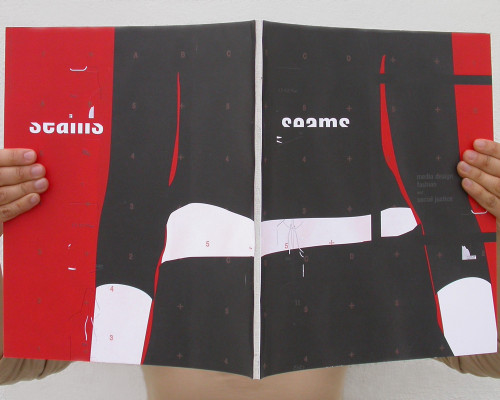
Seams catalogue
Adriana Parcero Studio, Los Angeles, California, 2003
Description
Women not only consume and wear more clothes than men, they manufacture more clothes than men do. There are millions of female garment workers all over the world constructing garments under substandard conditions. As both a consumer and media designer, I asked myself: How can I use media design to communicate the problem of sweatshops in an engaging way to women 25 years and older?
The objective of the Seams catalog is to describe some of the social and economic problems of the global garment industry, educate consumers about sweatshops, and encourage them to take social action.
Media coverage of the clothing industry primarily touches on the high and low ends of the industry, from high fashion, famous designers, and the models on catwalks to the drama behind clothing production—sweatshops. I wondered what would happen if I juxtaposed these two worlds. Could I use the language of fashion to talk about an unfashionable subject?
I used a variety of design and research methods in an attempt to answer my questions. For example, I used photography as a tool to analyze diverse, fashion-related contexts in Los Angeles, and did video-ethnographic research with people involved in the garment industry. During one of the interviews I conducted, I asked a garment worker to break down the cost of producing the sweatshirt I was wearing. At that moment, I realized the complex meaning of clothing for both of us. The process of explaining the cost of each part of the sweatshirt proved to be a medium capable of communicating a hidden story in a very clear way.
The Seams catalog both follows and subverts the usual catalog forms by enveloping an enticing vision of the clothes themselves in socially relevant content. It has four levels of information. The first is factual information on the garments. The second level is a narrative of a woman wearing the garments, who represents the potential customer. The third level of information is the catalog text and diagrams that complement the photographs, and provide more information about the garment industry. The fourth level, the index section, deploys an iconic language that describes the complex participants in the garment industry. Seven icons represent concepts and people. Brand owners and manufacturers, for example, are represented by a hybrid octopus/scissors.
The Seams collection maps the social and economic reality of the global garment industry onto four garments that describe the state of the industry in four countries: Japan, the United States, China and Bangladesh. Embroidered details and an innovative Production Facts Index (inspired by the Nutrition Facts label), provide contextual information about substandard production. By doing this, they became the message. Seams uses clothing as an information system to communicate socially relevant content. The clothes themselves are narratives that give voice to garment workers in a unique manner. Seams places activism within higher fashion by blurring the boundaries of the clothing industry, using high-end goods to comment on substandard production practices.
The Seams catalog has received very positive responses from a broader audience than initially targeted. About 14,000 people have had access to the print and/or Web version of the Seams catalog. All messages received have been positive and reassuring. Both women and men have requested more information on the subject and expressed interest in wearing the garments.
Juror Notes
Beautifully done; allows its message to come through in a very sophisticated way.
Credits
- Design firm
- Adriana Parcero Studio
- Creative director
- Adriana Parcero
- Designer
- Adriana Parcero
- Illustrator
- Adriana Parcero
- Photographer
- Isabel Avila
- Production director
- Adriana Parcero
- Picture editor
- Adriana Parcero
- Editors
- Nikolai Cornell, Adriana Parcero
- Writer
- Adriana Parcero
- Printer
- Page One Digital
- Printing method
- Indigo Digital Printing
- Binder
- Ponce e Hijos Encuadernaciones
- Binding method
- Perfect bound, hand stitched
- Paper
- Smart Papers Carnival Smooth Pure White 80# lb. cover
- Typeface
- Berthold Akzidenz Grotesk Bold Condensed



